fuel consumption SKODA OCTAVIA TOUR 2009 1.G / (1U) User Guide
[x] Cancel search | Manufacturer: SKODA, Model Year: 2009, Model line: OCTAVIA TOUR, Model: SKODA OCTAVIA TOUR 2009 1.G / (1U)Pages: 224, PDF Size: 13.53 MB
Page 139 of 224

Driving and the Environment
138
Catalytic converterProper operation of the emission co
ntrol system (catal
ytic converter)
is of major significance for drivin
g your vehicle in an environmen-
tally conscious way.Please refer to the following guidelines: – For vehicles with petrol engine
only refuel with unleaded petrol
⇒
page 155, “Grades of petrol”.
– Never run the fuel tank completely empty. – Do not switch off the ignition while you are driving the vehicle. – Do not pour too much oil into the engine
⇒
page 163, “Replenishing
engine oil”.
– Do not tow-start the vehicle over a
distance of more than 50 metres
⇒
page 191, “Tow-starting a vehicle”.
If you drive your vehi
cle in a country in which unleaded
petrol is not available, you
must have the catalytic converter replaced
later when driving the vehicle into a
country in which use of a cata
lytic converter is mandatory.
WARNING
•
In view of the high temperatures which may be produced in the catalytic
converter, one should always park a vehicle in such a way that the catalytic converter cannot come into contact with
easily flammable materials below
the vehicle - a risk of fire!•
Never use additional underbody protection or corrosion-protection
agents for the exhaust pipes, catalyti
c converters or heat shields. Such
substances might ignite when driving - risk of fire!
Caution
•
On vehicles fitted with
a catalytic converter, never let the fuel tank run
completely empty. An irregular fuel supply can result in poor ignition or misfiring. Unburnt fuel may get into the exhaust sy
stem and damage the catalytic converter.
•
Filling the tank even only once with le
aded petrol will resu
lt in the catalytic
converter being destroyed.•
If you detect misfiring, a drop in performance or irregular engine running when
driving, reduce your speed immediately and have the vehicle inspected by the nearest specialist garage. The symptoms described may be caused by a fault in the ignition system. Unburnt fuel may get in
to the exhaust system and damage the
catalytic converter.
For the sake of the environment
Even if the exhaust system is operating properly, a sulphur-like exhaust odour may be produced under certain op
erating conditions of the en
gine. This depends on the
sulphur content of the fuel. It is often su
fficient to refuel with unleaded premium-
grade petrol of a different brand or at a different filling station.Driving in an economical and environmentally conscious mannerGeneral Your personal style of driving is a major factor.Your fuel consumption, any pollution of
the environmental and the wear-and-tear
to the engine, brakes and tyres, depend essentially on three factors:•
your personal style of driving,
•
the conditions under which
your vehicle is operated,
•
technical aspects.
You can easily improve your fuel economy by 10 - 15 percent by driving in an economical way with foresight. This section is intended to provide you with a
s2g8.b.book Page 138 Tuesday, April 7, 2009 8:53 AM
Page 140 of 224

Driving and the Environment
139
Using the system
Safety
Driving Tips
General Maintenance
Breakdown assistance
Technical Data
number of tips on how to protect the environment and at the same time save money. The fuel consumption can naturally also be
influenced by factors which are beyond
the driver's control. It is,
for example, normal for the fu
el consumption to increase
in winter and under worsened
conditions such as poor road conditions, towing a
trailer, etc. The technical requirements for low fuel
usage and economic efficiency of the
vehicle have already been built into the ve
hicle at the works.
Special attention has
been given to minimising ne
gative effects on the environment. It is necessary to
take note of the guidelines given in this
chapter in order to make best use of these
characteristics and to maintain their effectiveness. The optimal engine speed should be obtained when accelerating, in order to avoid a high fuel consumption an
d resonance of the vehicle.
Looking ahead when driving A vehicle's highest fuel consumption occurs it accelerates.Avoid accelerating and brakin
g unnecessarily. If you drive
with forsight you will not
need to brake so often and will also then
not have to accelerate so much. Let your
vehicle coast to a stop, for example, if this
is possible, when you see that the next
set of traffic lights is at red.
Shifting gears and saving energy Shifting up early saves on fuel.Manual gearbox – Drive no more than about one length of your vehicle in first gear. – Always shift up into the next higher gear at approx. 2 000 to 2 500 revs.An effective way of achieving good
fuel economy is to shift up
early
. You will
consume more fuel if you drive at unnecessa
rily high revolutions in any given gear.
The
⇒fig. 141
shows the ratio of fuel consumption to the speed of your vehicle in
the relevant gears. Fuel consumption in 1st
gear is the highest and in 5th gear is the
lowest.
Note
Also use the information supplied by the multi-functional indicator*
⇒page 19.
Fig. 141 Fuel consumption in litres/100 km. and speed in km/h.
s2g8.b.book Page 139 Tuesday, April 7, 2009 8:53 AM
Page 141 of 224
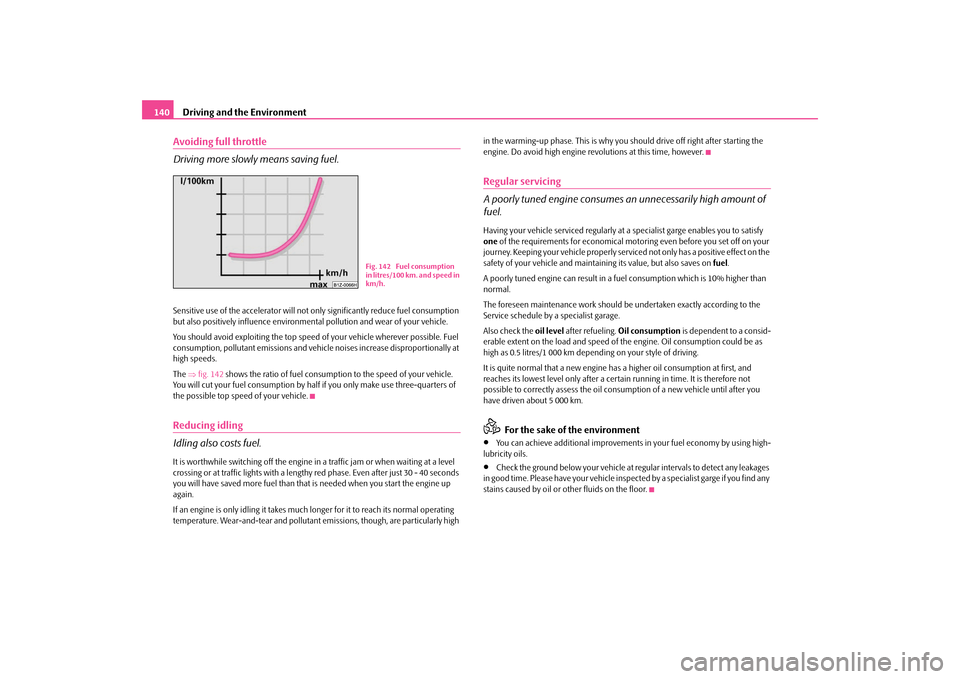
Driving and the Environment
140
Avoiding full throttle Driving more slowly means saving fuel.Sensitive use of the accelera
tor will not only significantly reduce fuel consumption
but also positively influence environmen
tal pollution and wear of your vehicle.
You should avoid exploiting the top speed
of your vehicle wherever possible. Fuel
consumption, pollutant emissi
ons and vehicle noises increase disproportionally at
high speeds. The
⇒fig. 142
shows the ratio of fuel consumption to the speed of your vehicle.
You will cut your fuel consumption by half
if you only make use three-quarters of
the possible top speed of your vehicle.Reducing idling Idling also costs fuel.It is worthwhile switching off the engine in
a traffic jam or when waiting at a level
crossing or at traffic lights with a length
y red phase. Even after just 30 - 40 seconds
you will have saved more fuel than that
is needed when you start the engine up
again. If an engine is only idling it takes much
longer for it to reach its normal operating
temperature. Wear-and-tear and pollutant em
issions, though, are particularly high
in the warming-up phase. This is why you
should drive off right after starting the
engine. Do avoid high engine re
volutions at this time, however.
Regular servicing A poorly tuned engine consumes an unnecessarily high amount of fuel.Having your vehicle serviced regularly at a specialist garge enables you to satisfy one
of the requirements for economical moto
ring even before you set off on your
journey. Keeping your vehicle properly servic
ed not only has a positive effect on the
safety of your vehicle and maintaining its value, but also saves on
fuel
.
A poorly tuned engine can result in a fu
el consumption which is 10% higher than
normal. The foreseen maintenance work should be undertaken exactly according to the Service schedule by a specialist garage. Also check the
oil level
after refueling.
Oil consumption
is dependent to a consid-
erable extent on the load and speed of
the engine. Oil consum
ption could be as
high as 0.5 litres/1 000 km depending on your style of driving. It is quite normal that a new engine ha
s a higher oil consumption at first, and
reaches its lowest level only
after a certain running in
time. It is therefore not
possible to correctly assess the oil cons
umption of a new vehicle until after you
have driven about 5 000 km.
For the sake of the environment
•
You can achieve additional improvements
in your fuel economy by using high-
lubricity oils.•
Check the ground below your vehicle at re
gular intervals to detect any leakages
in good time. Please have yo
ur vehicle inspected by a specialist garge if you find any
stains caused by oil or
other fluids on the floor.
Fig. 142 Fuel consumption in litres/100 km. and speed in km/h.
s2g8.b.book Page 140 Tuesday, April 7, 2009 8:53 AM
Page 142 of 224
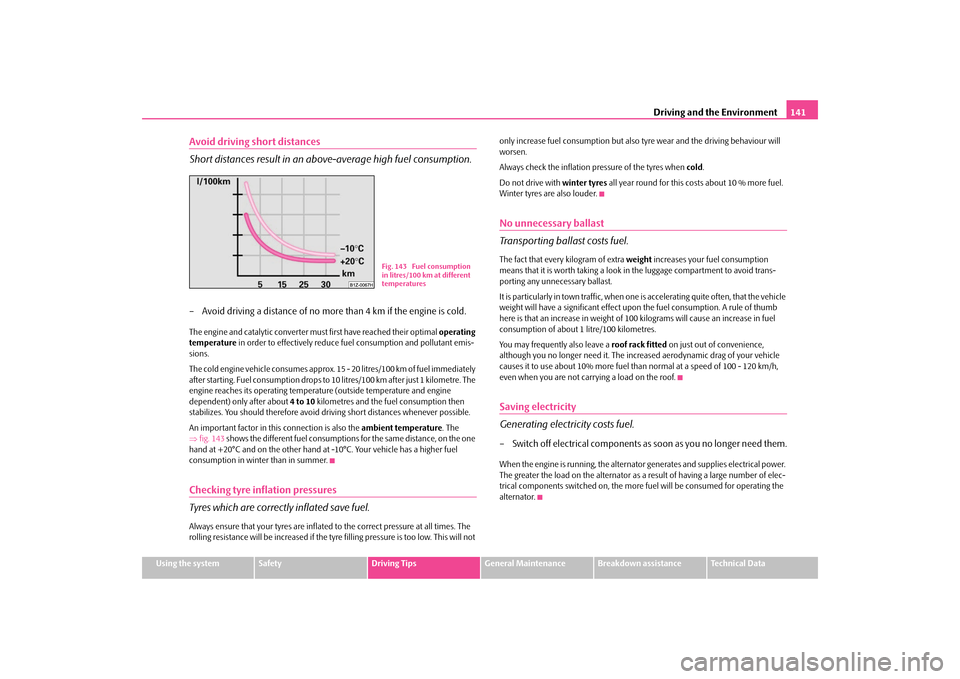
Driving and the Environment
141
Using the system
Safety
Driving Tips
General Maintenance
Breakdown assistance
Technical Data
Avoid driving short distances Short distances result in an above-average high fuel consumption.– Avoid driving a distance of no more than 4 km if the engine is cold.The engine and catalytic converter mu
st first have reached their optimal
operating
temperature
in order to effectively reduce fu
el consumption and pollutant emis-
sions. The cold engine vehicle consumes approx. 15 - 20 litres/100 km of fuel immediately after starting. Fuel co
nsumption drops to 10 litres/100 km after just 1 kilometre. The
engine reaches its operating temperat
ure (outside temperature and engine
dependent) only after about
4 to 10
kilometres and the fuel consumption then
stabilizes. You should therefore avoid driving short distances whenever possible. An important factor in this connection is also the
ambient temperature
. The
⇒ fig. 143
shows the different fuel consumptions for the same distance, on the one
hand at +20°C and on the other hand at
-10°C. Your vehicle has a higher fuel
consumption in winter than in summer.Checking tyre inflation pressures Tyres which are correctly inflated save fuel.Always ensure that your tyres are inflated
to the correct pressure at all times. The
rolling resistance will be increased if the tyre filling pressure is too low. This will not
only increase fuel consumption but also
tyre wear and the driving behaviour will
worsen. Always check the inflation pressure of the tyres when
cold
.
Do not drive with
winter tyres
all year round for this costs about 10 % more fuel.
Winter tyres are also louder.No unnecessary ballast Transporting ballast costs fuel.The fact that every kilogram of extra
weight
increases your fuel consumption
means that it is worth taking a look in the luggage compartment to avoid trans- porting any unnecessary ballast. It is particularly in town traffic, when one
is accelerating quite often, that the vehicle
weight will have a significant effect upon
the fuel consumption. A rule of thumb
here is that an increase in weight of 100
kilograms will cause an increase in fuel
consumption of about 1
litre/100 kilometres.
You may frequently also leave a
roof rack fitted
on just out of convenience,
although you no longer need it. The incr
eased aerodynamic drag of your vehicle
causes it to use about 10% more fuel th
an normal at a speed of 100 - 120 km/h,
even when you are not carr
ying a load on the roof.
Saving electricity Generating electricity costs fuel.– Switch off electrical components as
soon as you no longer need them.
When the engine is running, the alternator
generates and supplies
electrical power.
The greater the load on the alternator as a result of having a large number of elec-trical components switched on, the more
fuel will be consumed for operating the
alternator.
Fig. 143 Fuel consumption in litres/100 km at different temperatures
s2g8.b.book Page 141 Tuesday, April 7, 2009 8:53 AM
Page 143 of 224
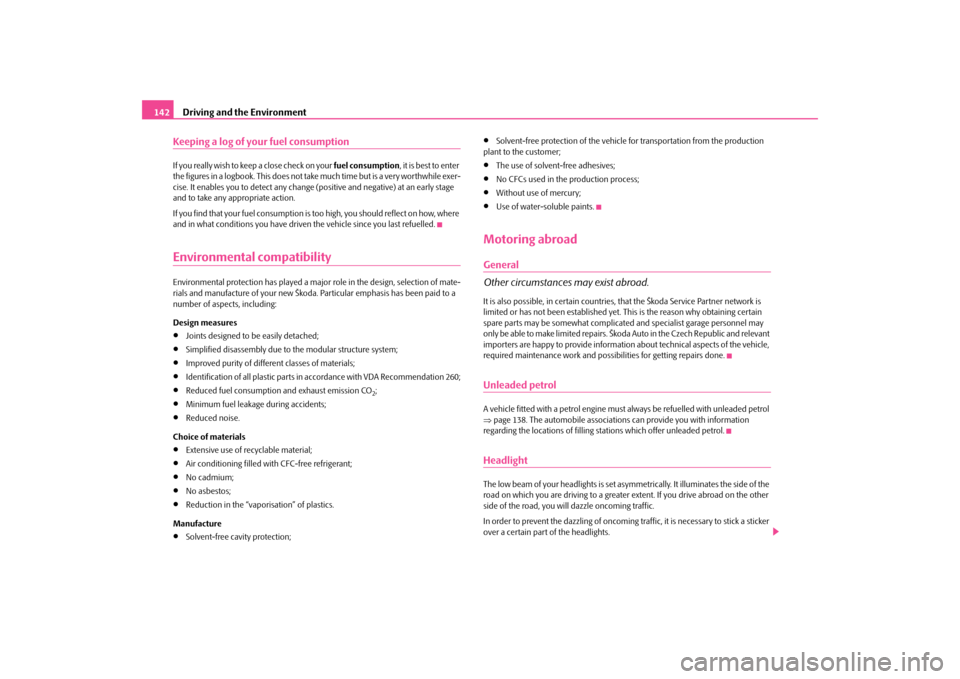
Driving and the Environment
142
Keeping a log of your fuel consumptionIf you really wish to ke
ep a close check on your
fuel consumption
, it is best to enter
the figures in a logbook. This does not take
much time but is a very worthwhile exer-
cise. It enables you to detect any change
(positive and negative) at an early stage
and to take any appropriate action. If you find that your fuel
consumption is too high, you sh
ould reflect on how, where
and in what conditions you have driven
the vehicle since you last refuelled.
Environmental compatibilityEnvironmental protection has played a majo
r role in the design, selection of mate-
rials and manufacture of your new Škoda.
Particular emphasis
has been paid to a
number of aspects, including: Design measures•
Joints designed to
be easily detached;
•
Simplified disassembly due to the modular structure system;
•
Improved purity of differ
ent classes of materials;
•
Identification of all plastic parts in
accordance with VDA Recommendation 260;
•
Reduced fuel consumption
and exhaust emission CO
2;
•
Minimum fuel leakage during accidents;
•
Reduced noise.
Choice of materials•
Extensive use of recyclable material;
•
Air conditioning filled wi
th CFC-free refrigerant;
•
No cadmium;
•
No asbestos;
•
Reduction in the “vaporisation” of plastics.
Manufacture•
Solvent-free cavity protection;
•
Solvent-free protection of the vehicle for transportation from the production
plant to the customer;•
The use of solvent-free adhesives;
•
No CFCs used in the production process;
•
Without use of mercury;
•
Use of water-soluble paints.
Motoring abroadGeneral Other circumstances may exist abroad.It is also possible, in certain countries, that the Škoda Service Partner network is limited or has not been established yet.
This is the reason why obtaining certain
spare parts may be somewhat complicate
d and specialist garage personnel may
o n l y b e a b l e t o m a ke l i m i te d re p a i rs . Š ko d a A u to i n t h e C z e c h R e pu b l i c a n d re l e v a n t importers are happy to provide information
about technical aspects of the vehicle,
required maintenance work and possibilities for getting repairs done.Unleaded petrolA vehicle fitted with a petrol engine must always be refuelled with unleaded petrol ⇒ page 138. The automobile associations can provide you with information regarding the locations of filling stations which offer unleaded petrol.HeadlightThe low beam of your headlights is set asym
metrically. It illuminates the side of the
road on which you are driving to a greater
extent. If you drive abroad on the other
side of the road, you wi
ll dazzle oncoming traffic.
In order to prevent the dazzling of oncoming traffic, it is necessary to stick a sticker over a certain part of the headlights.
s2g8.b.book Page 142 Tuesday, April 7, 2009 8:53 AM
Page 156 of 224
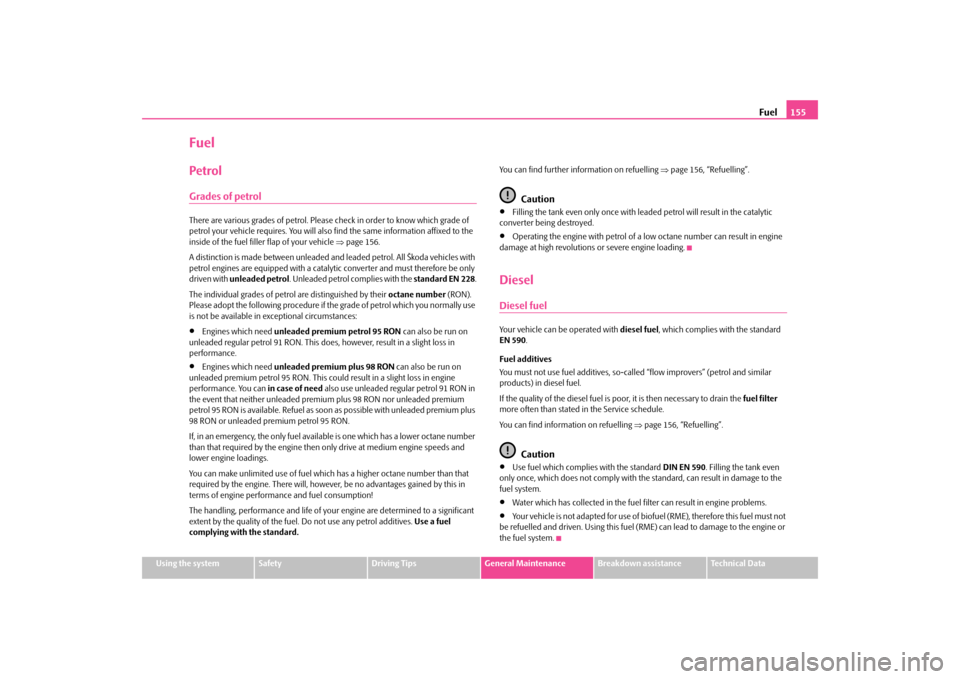
Fuel
155
Using the system
Safety
Driving Tips
General Maintenance
Breakdown assistance
Technical Data
FuelPetrolGrades of petrolThere are various grades of petrol. Please
check in order to know which grade of
petrol your vehicle requires.
You will also find the same information affixed to the
inside of the fuel filler flap of your vehicle
⇒page 156.
A distinction is made between unleaded an
d leaded petrol. All Škoda vehicles with
petrol engines are equipped with a catalyti
c converter and must therefore be only
driven with
unleaded petrol
. Unleaded petrol complies with the
standard EN 228
.
The individual grades of petr
ol are distinguished by their
octane number
(RON).
Please adopt the following procedure if the grade of petrol which you normally use is not be available in
exceptional circumstances:
•
Engines which need
unleaded premium petrol 95 RON
can also be run on
unleaded regular petrol 91 RON. This does, however, result in a slight loss in performance.•
Engines which need
unleaded premium plus 98 RON
can also be run on
unleaded premium petrol 95 RON. This coul
d result in a slight loss in engine
performance. You can
in case of need
also use unleaded regular petrol 91 RON in
the event that neither unleaded premiu
m plus 98 RON nor unleaded premium
petrol 95 RON is available. Refuel as soon as possible with unleaded premium plus 98 RON or unleaded premium petrol 95 RON. If, in an emergency, the only fuel availa
ble is one which has a lower octane number
than that required by the engine then only drive at medium engine speeds and lower engine loadings. You can make unlimited use of fuel whic
h has a higher octane
number than that
required by the engine. There will, howeve
r, be no advantages gained by this in
terms of engine performance and fuel consumption! The handling, performance and
life of your engine are determined to a significant
extent by the quality of the fuel.
Do not use any petrol additives.
Use a fuel
complying with
the standard.
You can find further information on refuelling
⇒page 156, “Refuelling”.
Caution
•
Filling the tank even only once with lead
ed petrol will result in the catalytic
converter being destroyed.•
Operating the engine with petrol of a lo
w octane number can result in engine
damage at high revolutions or severe engine loading.DieselDiesel fuelYour vehicle can be operated with
diesel fuel
, which complies with the standard
EN 590
.
Fuel additives You must not use fuel additives, so-called “flow improvers” (petrol and similar products) in diesel fuel. If the quality of the diesel fuel is poor, it is then necessary to drain the
fuel filter
more often than stated in the Service schedule. You can find information on refuelling
⇒page 156, “Refuelling”.
Caution
•
Use fuel which complies with the standard
DIN EN 590
. Filling the tank even
only once, which does not comply with th
e standard, can result
in damage to the
fuel system.•
Water which has collected in the fuel fi
lter can result in engine problems.
•
Your vehicle is not adapted
for use of biofuel (RME), therefore this fuel must not
be refuelled and driven. Using this fuel (RME) can lead to damage to the engine or the fuel system.
s2g8.b.book Page 155 Tuesday, April 7, 2009 8:53 AM
Page 164 of 224
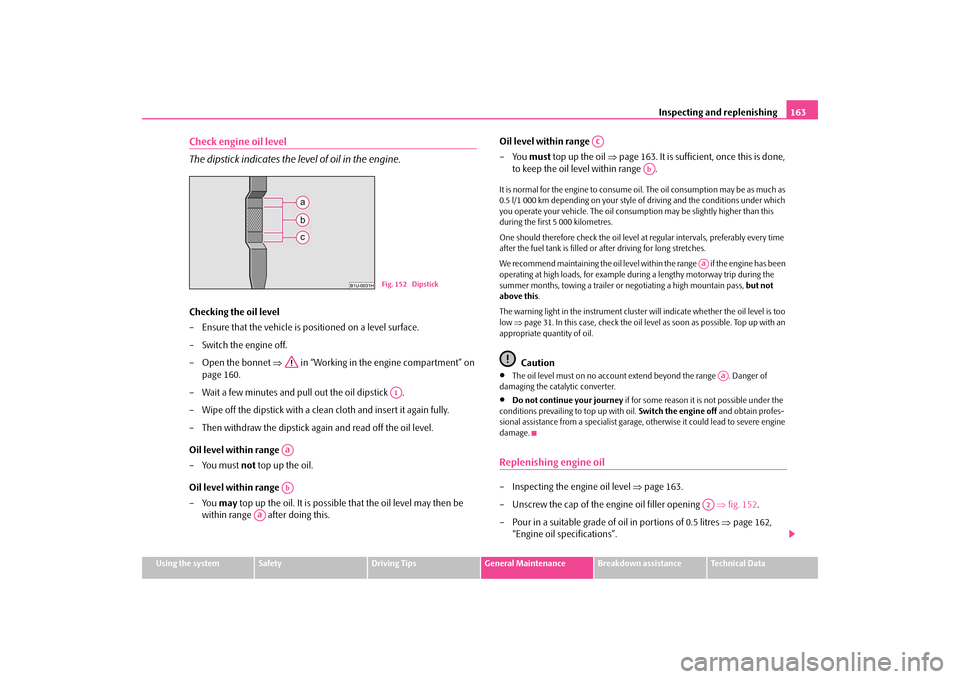
Inspecting and replenishing
163
Using the system
Safety
Driving Tips
General Maintenance
Breakdown assistance
Technical Data
Check engine oil level The dipstick indicates the level of oil in the engine.Checking the oil level – Ensure that the vehicle is positioned on a level surface. – Switch the engine off.– Open the bonnet
⇒
in “Working in the engine compartment” on
page 160.
– Wait a few minutes and pull out the oil dipstick . – Wipe off the dipstick with a clea
n cloth and insert it again fully.
– Then withdraw the dipstick ag
ain and read off the oil level.
Oil level within range – You must
not
top up the oil.
Oil level within range – You
may
top up the oil. It is possible that the oil level may then be
within range after doing this.
Oil level within range –You
must
top up the oil
⇒
page 163. It is sufficient, once this is done,
to keep the oil level within range .
It is normal for the engine to consume oi
l. The oil consumption may be as much as
0.5 l/1 000 km depending on your style of driving and the conditions under which you operate your vehicle. The oil consumpt
ion may be slightly higher than this
during the first 5 000 kilometres. One should therefore check the oil level at regular intervals, preferably every time after the fuel tank is filled or after driving for long stretches. We recommend maintaining the oil level within the range if the engine has been operating at high loads, for example during a lengthy motorway trip during the summer months, towing a trailer or
negotiating a high mountain pass,
but not
above this
.
The warning light in the instrument cluster
will indicate whether the oil level is too
low
⇒page 31. In this case, check the oil level
as soon as possible. Top up with an
appropriate quantity of oil.
Caution
•
The oil level must on no account ex
tend beyond the range . Danger of
damaging the cata
lytic converter.
•
Do not continue your journey
if for some reason it is not possible under the
conditions prev
ailing to top up with oil.
Switch the engine off
and obtain profes-
sional assistance from a specialist garage, otherwise it could lead to severe engine damage.Replenishing engine oil– Inspecting the engine oil level
⇒
page 163.
– Unscrew the cap of the engine oil filler opening
⇒
fig. 152
.
– Pour in a suitable grade of oil in portions of 0.5 litres
⇒
page 162,
“Engine oil specifications”.
Fig. 152 DipstickA1
AaAb
Aa
Ac
Ab
Aa
Aa
A2
s2g8.b.book Page 163 Tuesday, April 7, 2009 8:53 AM
Page 175 of 224
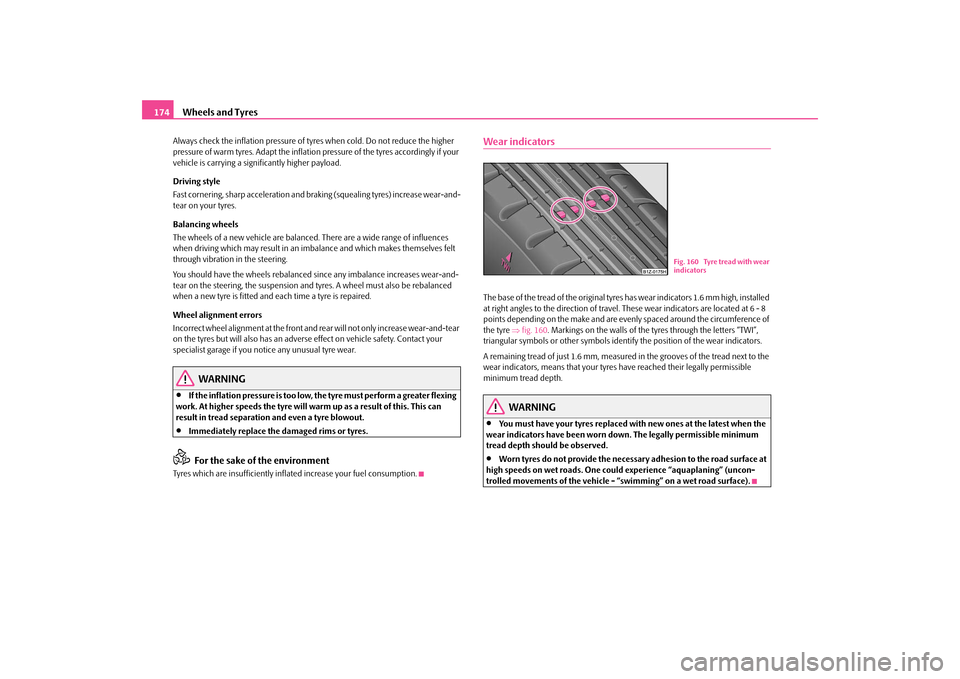
Wheels and Tyres
174
Always check the inflation pressure of ty
res when cold. Do not reduce the higher
pressure of warm tyres. Adapt the inflation pressure of the tyres accordingly if your vehicle is carrying a significantly higher payload. Driving style Fast cornering, sharp acceleration and braking (squealing tyres) increase wear-and- tear on your tyres. Balancing wheels The wheels of a new vehicle are balanced. There are a wide range of influences when driving which may result in an imbalance and which makes themselves felt through vibration in the steering. You should have the wheels rebalanced
since any imbalance increases wear-and-
tear on the steering, the suspension and
tyres. A wheel must also be rebalanced
when a new tyre is fitted and each time a tyre is repaired. Wheel alignment errors Incorrect wheel alignment at the front and re
ar will not only increase wear-and-tear
on the tyres but will also has an adverse
effect on vehicle safety. Contact your
specialist garage if you notice any unusual tyre wear.
WARNING
•
If the inflation pressure is too low,
the tyre must perform a greater flexing
work. At higher speeds the tyre will warm up as a result of this. This can result in tread separation and even a tyre blowout.•
Immediately replace the damaged rims or tyres.For the sake of the environment
Tyres which are insufficiently inflated increase your fuel consumption.
Wear indicatorsThe base of the tread of the original tyres has wear indicators 1.6 mm high, installed at right angles to the direction of travel. These wear indicators are located at 6 - 8 points depending on the make and are evenly spaced around the circumference of the tyre
⇒fig. 160
. Markings on the walls of the
tyres through the letters “TWI”,
triangular symbols or other symbols identi
fy the position of the wear indicators.
A remaining tread of just 1.6 mm, measured in the grooves of the tread next to the wear indicators, means that your tyres
have reached their legally permissible
minimum tread depth.
WARNING
•
You must have your tyres replaced with new ones at the latest when the
wear indicators have been worn do
wn. The legally permissible minimum
tread depth should be observed.•
Worn tyres do not provide the necessar
y adhesion to the road surface at
high speeds on wet roads. One coul
d experience “aquaplaning” (uncon-
trolled movements of the vehicle - “swimming” on a wet road surface).
Fig. 160 Tyre tread with wear indicators
s2g8.b.book Page 174 Tuesday, April 7, 2009 8:53 AM
Page 178 of 224
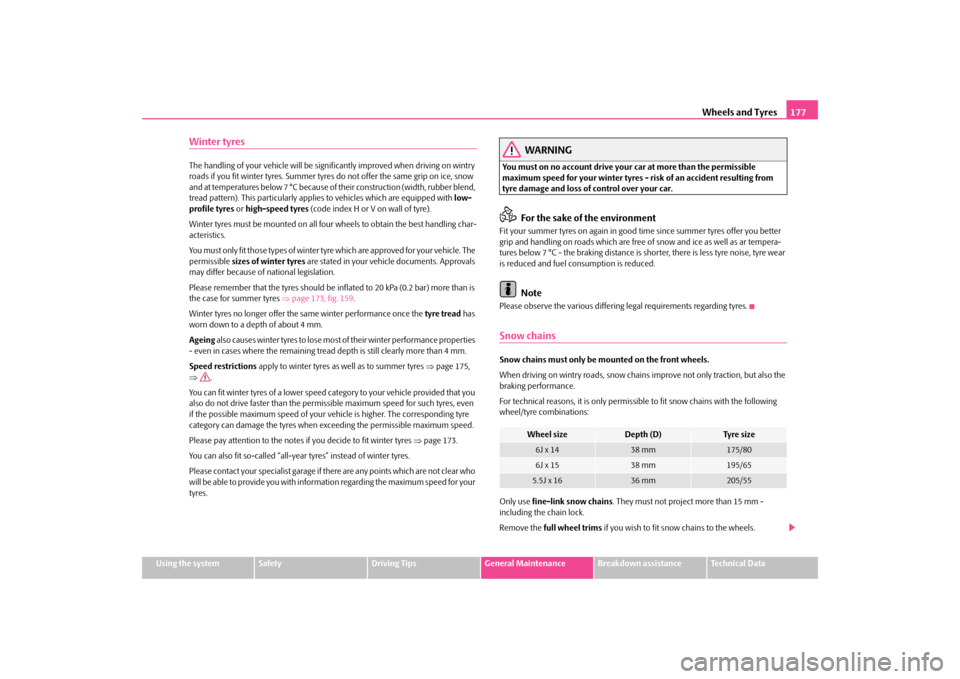
Wheels and Tyres
177
Using the system
Safety
Driving Tips
General Maintenance
Breakdown assistance
Technical Data
Winter tyresThe handling of your vehicle will be significantly improved when driving on wintry roads if you fit winter tyres. Summer tyres do not offer the same grip on ice, snow and at temperatures below 7 °C because of
their construction (width, rubber blend,
tread pattern). This partic
ularly applies to vehicles
which are equipped with
low-
profile tyres
or high-speed tyres
(code index H or V on wall of tyre).
Winter tyres must be mounted on all four wheels to obtain the best handling char- acteristics. You must only fit those types of winter tyre which are approved for your vehicle. The permissible
sizes of winter tyres
are stated in your vehicle documents. Approvals
may differ because of national legislation. Please remember that the tyres should be in
flated to 20 kPa (0.2 bar) more than is
the case for summer tyres
⇒page 173, fig. 159
.
Winter tyres no longer
offer the same winter performance once the
tyre tread
has
worn down to a depth of about 4 mm. Ageing
also causes winter tyres to lose most of their winter performance properties
- even in cases where the remaining tread depth is still clearly more than 4 mm. Speed restrictions
apply to winter tyres as well as to summer tyres
⇒page 175,
⇒
.
You can fit winter tyres of a lower speed ca
tegory to your vehicle provided that you
also do not drive faster than the permis
sible maximum speed fo
r such tyres, even
if the possible maximum speed of your ve
hicle is higher. The corresponding tyre
category can damage the tyres when ex
ceeding the permissi
ble maximum speed.
Please pay attention to the notes if
you decide to fit winter tyres
⇒page 173.
You can also fit so-called “all-year tyres” instead of winter tyres.Please contact your specialist garage if
there are any points which are not clear who
will be able to provide you with information regarding the maximum speed for your tyres.
WARNING
You must on no account drive your car at more than the permissible maximum speed for your winter tyres - risk of an accident resulting from tyre damage and loss of control over your car.
For the sake of the environment
Fit your summer tyres on again in good ti
me since summer tyres offer you better
grip and handling on roads which are free of snow and ice as well as ar tempera-tures below 7 °C - the braking distance is shorter, there is less tyre noise, tyre wear is reduced and fuel consumption is reduced.
Note
Please observe the various differing legal requirements regarding tyres.Snow chainsSnow chains must only be mounted on the front wheels. When driving on wintry roads, snow chains
improve not only traction, but also the
braking performance. For technical reasons, it is only permissi
ble to fit snow chains with the following
wheel/tyre combinations: Only use
fine-link snow chains
. They must not project more than 15 mm -
including the chain lock. Remove the
full wheel trims
if you wish to fit snow
chains to the wheels.
Wheel size
Depth (D)
Ty re s i z e
6J x 14
38 mm
175/80
6J x 15
38 mm
195/65
5.5J x 16
36 mm
205/55
s2g8.b.book Page 177 Tuesday, April 7, 2009 8:53 AM
Page 203 of 224
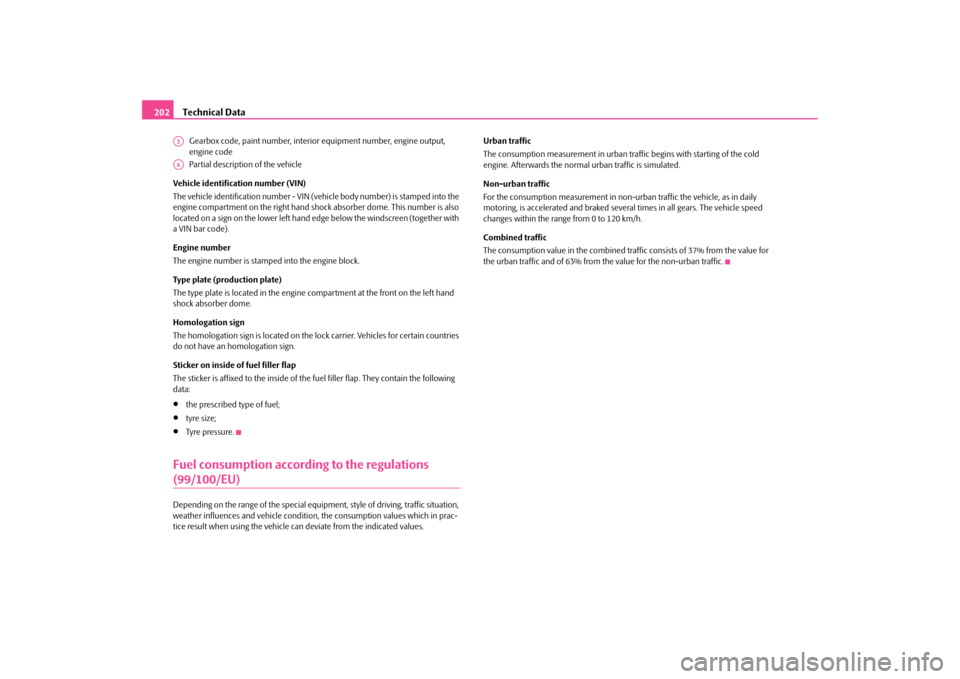
Technical Data
202
Gearbox code, paint number, interior
equipment number, engine output,
engine code Partial description of the vehicle
Vehicle identification number (VIN) The vehicle identification num
ber - VIN (vehicle body number) is stamped into the
engine compartment on the right hand shoc
k absorber dome. This number is also
located on a sign on the lower left hand
edge below the windscreen (together with
a VIN bar code). Engine number The engine number is stamped into the engine block. Type plate (production plate) The type plate is located in the engine co
mpartment at the front on the left hand
shock absorber dome. Homologation sign The homologation sign is located on the lo
ck carrier. Vehicles for certain countries
do not have an homologation sign. Sticker on inside of fuel filler flap The sticker is affixed to the inside of the fuel filler flap. They contain the following data:•
the prescribed type of fuel;
•
tyre size;
•
Tyre pressure.
Fuel consumption according to the regulations (99/100/EU)Depending on the range of the special equipment, style of driving, traffic situation, weather influences an
d vehicle condition, the consum
ption values which in prac-
tice result when using the vehicle ca
n deviate from the indicated values.
Urban traffic The consumption measurement in urban traf
fic begins with starting of the cold
engine. Afterwards the normal
urban traffic is simulated.
Non-urban traffic For the consumption measurement in non-ur
ban traffic the vehicle, as in daily
motoring, is accelerated and braked several times in all gears. The vehicle speed changes within the range from 0 to 120 km/h. Combined traffic The consumption value in the combined traf
fic consists of 37%
from the value for
the urban traffic and of 63% from
the value for the non-urban traffic.
A3A4s2g8.b.book Page 202 Tuesday, April 7, 2009 8:53 AM